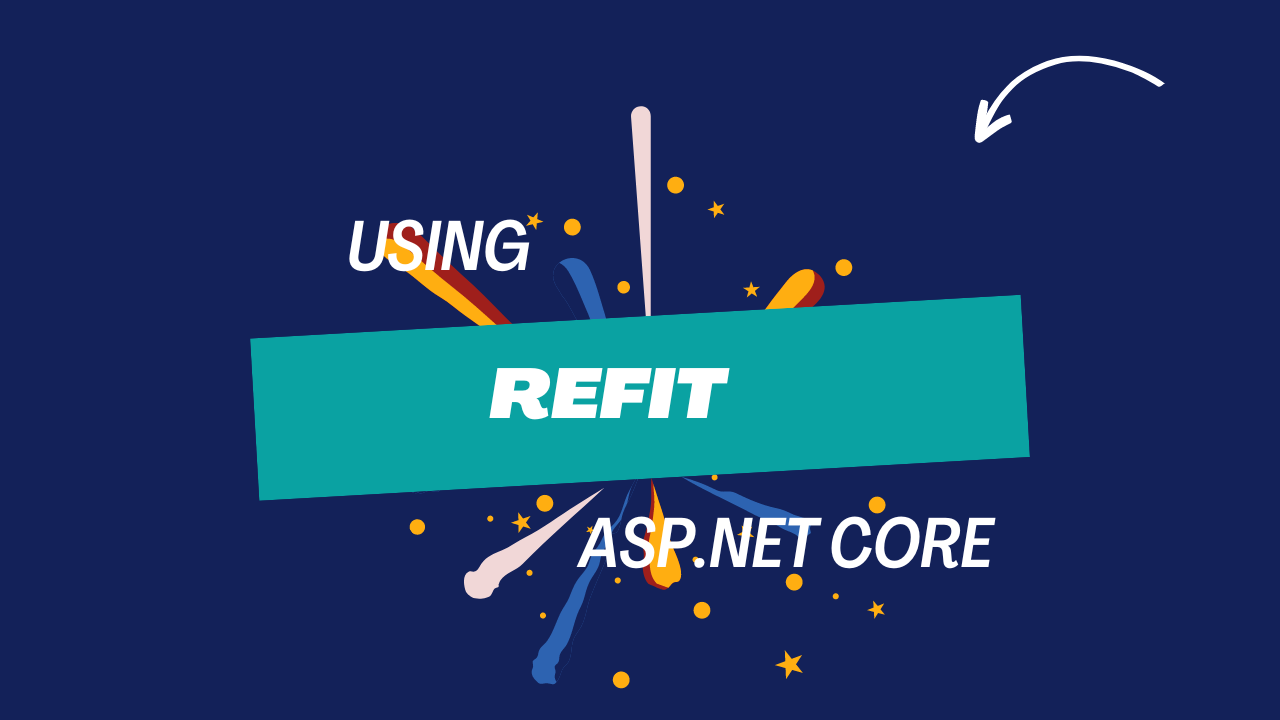ASP.NET Core 7 WebAPI Refit
ASP .NET Core Project for learning. Every one should be able to use this templae to build a ASP .NET Core web API with Refit and Fake API. 0 commentsBy Sopheaktra Eang | July 04, 2024
- Swagger for API's Endpoint
- API-Versioning
- Refit
These instructions will get you to setup the project, install sdk and add package (CLI or Package manager console).
- Visual Studio 2022 or higher
- .NET 7.x SDK
- Install .net SDK 7
Download .NET SDK here. - Create new Web API's project
dotnet new webapi –-name ASP.NET_Core7_WebAPI_Refit - Add package
- API-Versioning
dotnet add package Asp.Versioning.Mvc.ApiExplorer - Refit
dotnet add package Refit
- API-Versioning
What's Refit?
Refit is an automatic type-safe REST library for .NET Core, Xamarin, and .NET. It’s heavily inspired by Square’s Retrofit library. With Refit, you can turn your REST API into a live interface.
How it works?
Here’s how it works:
- Define an Interface: Create an interface that represents your API. For example:
public interface IApi
{
[Get("/users/{user}")]
Task<User> GetUser(string user);
}- Generate Implementation: Refit generates an implementation of
IGitHubApithat usesHttpClientto make API calls:
var api = RestService.For<IApi>("https://api.com");
var result = await api.GetUser("octocat");- HttpClientFactory Support: .NET Core supports registering Refit clients via
HttpClientFactoryservices:
services.AddRefitClient<IApi>()
.ConfigureHttpClient(c => c.BaseAddress = new Uri("https://api.com"));- Features:
- Querystrings
- Dynamic querystring parameters
- Custom querystring parameter formatting
- Body content
- Request headers (static and dynamic)
- Bearer authentication
- Exception handling
- Multipart uploads
- Using generic interfaces
- ...etc
Refit enhances reliability and quality assurance by providing a type-safe way to consume APIs in your ASP.NET Core applications.
Let's Start Code with ASP.NET Core
Override config 'appsettings.json':
{
"Logging": {
"LogLevel": {
"Default": "Information",
"Microsoft.AspNetCore": "Warning"
}
},
"AllowedHosts": "*",
"FakeAPI": {
"URL": "https://fakestoreapi.com/"
}
}And then override 'Program.cs':
using Asp.Versioning;
using ASP.NET_Core7_WebAPI_Refit.Services;
using ASP.NET_Core7_WebAPI_Refit.Configurations.Swagger;
using Microsoft.Extensions.Options;
using Refit;
using Swashbuckle.AspNetCore.SwaggerGen;
const string SwaggerRoutePrefix = "api-docs";
var builder = WebApplication.CreateBuilder(args);
// Add services to the container.
builder.Services.AddControllers();
builder.Services
.AddApiVersioning(
options =>
{
// reporting api versions will return the headers "api-supported-versions" and "api-deprecated-versions"
options.ReportApiVersions = true;
})
.AddApiExplorer(options =>
{
options.DefaultApiVersion = new ApiVersion(1, 0);
// Add the versioned API explorer, which also adds IApiVersionDescriptionProvider service
// note: the specified format code will format the version as "'v'major[.minor][-status]"
options.GroupNameFormat = "'v'VVV";
// note: this option is only necessary when versioning by url segment. the SubstitutionFormat
// can also be used to control the format of the API version in route templates
options.SubstituteApiVersionInUrl = true;
options.AssumeDefaultVersionWhenUnspecified = true;
});
// Learn more about configuring Swagger/OpenAPI at https://aka.ms/aspnetcore/swashbuckle
builder.Services.AddEndpointsApiExplorer();
builder.Services.AddTransient<IConfigureOptions<SwaggerGenOptions>, ConfigureSwaggerOptions>();
builder.Services.AddSwaggerGen(options =>
{
// Add a custom operation filter which sets default values
options.OperationFilter<SwaggerDefaultValues>();
});
string FakeAPIUrl = builder.Configuration["FakeAPI:URL"] ?? string.Empty;
//add Refit for User Fake API
builder.Services.AddScoped<IUsersApiClientService>(x => RestService.For<IUsersApiClientService>(FakeAPIUrl));
//add Regit for Product Fake API
builder.Services.AddScoped<IProductsApiClientService>(x => RestService.For<IProductsApiClientService>(FakeAPIUrl));
//add Regit for Cart Fake API
builder.Services.AddScoped<ICartsApiClientService>(x => RestService.For<ICartsApiClientService>(FakeAPIUrl));
var app = builder.Build();
// Configure the HTTP request pipeline.
if (app.Environment.IsDevelopment())
{
app.UseSwagger(options => { options.RouteTemplate = $"{SwaggerRoutePrefix}/{{documentName}}/docs.json"; });
app.UseSwaggerUI(options =>
{
options.RoutePrefix = SwaggerRoutePrefix;
foreach (var description in app.DescribeApiVersions())
options.SwaggerEndpoint($"/{SwaggerRoutePrefix}/{description.GroupName}/docs.json", description.GroupName.ToUpperInvariant());
});
}
app.UseHttpsRedirection();
app.MapControllers();
app.Run();In this tutorial I am using FAKE API with 3 Serivces:
- ICartsApiClientService: using for consume carts's API: create service "Services/ICartsApiClientService.cs":
using ASP.NET_Core7_WebAPI_Refit.Dtos.Cart;
using ASP.NET_Core7_WebAPI_Refit.Payloads.Requests.Cart;
using Refit;
namespace ASP.NET_Core7_WebAPI_Refit.Services {
public interface ICartsApiClientService {
[Get("/carts")]
Task<IEnumerable<CartDto>> GetAllCartsQuery(QueryParamCart queryParam);
[Get("/carts/user/{userId}")]
Task<IEnumerable<CartDto>> GetAllCartsByUserId(int userId);
[Get("/carts/{id}")]
Task<CartDto> GetCartById(int id);
[Post("/carts")]
Task<CartDto> CreateCart(CreateCartDto createCartDto);
[Put("/carts")]
Task<CartDto> UpdateCart(UpdateCartDto updateCartDto);
[Delete("/carts/{id}")]
Task<CartDto> DeleteCartById(int id);
}
}- IProductsApiClientService: using for consume products's API: create service "Services/IProductsApiClientService.cs":
using ASP.NET_Core7_WebAPI_Refit.Dtos.Product;
using ASP.NET_Core7_WebAPI_Refit.Payloads.Requests;
using Refit;
namespace ASP.NET_Core7_WebAPI_Refit.Services {
public interface IProductsApiClientService {
[Get("/products")]
Task<IEnumerable<ProductDto>> GetAllProductsQuery(QueryParam queryParam);
[Get("/products/category/{category}")]
Task<IEnumerable<ProductDto>> GetAllProductsByCategory(string category);
[Get("/products/{id}")]
Task<ProductDto> GetProductById(int id);
[Post("/products")]
Task<ProductDto> CreateProduct(CreateProductDto createProductDto);
[Put("/products")]
Task<ProductDto> UpdateProduct(UpdateProductDto updateProductDto);
[Delete("/products/{id}")]
Task<ProductDto> DeleteProductById(int id);
}
}- IUsersApiClientService: using for consume users's API: create service "Services/IUsersApiClientService.cs":
using ASP.NET_Core7_WebAPI_Refit.Dtos.User;
using ASP.NET_Core7_WebAPI_Refit.Payloads.Requests;
using Refit;
namespace ASP.NET_Core7_WebAPI_Refit.Services {
public interface IUsersApiClientService {
[Get("/users")]
Task<IEnumerable<UserDto>> GetAllUsersQuery(QueryParam queryParam);
[Get("/users/{id}")]
Task<UserDto> GetUserById(int id);
[Post("/users")]
Task<UserDto> CreateUser(CreateUserDto createUserDto);
[Put("/users")]
Task<UserDto> UpdateUser(UpdateUserDto updateUserDto);
[Delete("/users/{id}")]
Task<UserDto> DeleteUserById(int id);
}
}Summary
Download the source code for the sample application implementing rest service on application. Also you will learn about refit and consume api for faster and easy.

